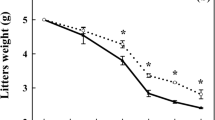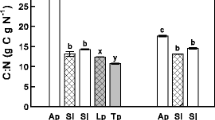Abstract
Microbial plant symbionts have been suggested to mediate plant-soil feedback and affect ecosystem functions. Systemic Epichloë fungal endophytes of grasses are found to mediate litter decomposition. These effects are often linked to alkaloids produced by Epichloë species, which are hypothesized to negatively affect decomposers. Although endophytes have been found to affect plant community and soil biota, direct (through litter quality) and indirect (through the environment) effects of fungal endophytes on litter decomposition have been scarcely scrutinized. We placed litterbags with endophyte-symbiotic (E+) and non-symbiotic (E−) Schedonorus pratensis plant litter in plots dominated by E+ or E− plants of the same species, and followed the dynamics of mass losses over time. We predicted the endophyte would hinder decomposition through changes in litter quality and that both types of litter would decompose faster in home environments. E+ litter decomposed faster in both environments. The mean difference between decomposition rate of E+ and E− litter tended to be higher in E− plots. Nitrogen and phosphorus, two elements usually associated with high decomposition rates, were significantly lower in E+ litter. We also detected a higher proportion of C in the cellulose form in E+ litter. Contrary to the general assumption, we found that symbiosis with Epichloë fungal endophytes can be associated with higher decomposition of plant litter. Since direct effects of Epichloë fungi were still stronger than indirect effects, it is suggested that besides the alkaloids, other changes in plant biomass would explain in a context-dependent manner, the endophyte effects on the litter decomposition.


Similar content being viewed by others
References
Austin AT, Vivanco L, González-Arzac A, Pérez LI (2014) There’s no place like home? An exploration of the mechanisms behind plant litter-decomposer affinity in terrestrial ecosystems. New Phytol 204:307–314
Ayres E, Dromph KM, Bardgett RD (2006) Do plant species encourage soil biota that specialise in the rapid decomposition of their litter? Soil Biol Biochem 38:183–186
Buyer JS, Zuberer DA, Nichols KA, Franzluebbers AJ (2011) Soil microbial community function, structure, and glomalin in response to tall fescue endophyte infection. Plant Soil 339:401–412
Bylin AG, Hume DE, Card SD, Mace WJ, Lloyd-West CM, Huss-Danell K (2014) Influence of nitrogen fertilization on growth and loline alkaloid production of meadow fescue (Festuca pratensis) associated with the fungal symbiont Neotyphodium uncinatum. Botany 92:370–376
Clay K (1988) Fungal endophytes of grasses: a defensive mutualism between plants and fungi. Ecology 69:10–16
Cleveland CC, Reed SC, Keller AB, Nemergut DR, O’Neill SP, Ostertag R, Vitousek PM (2014) Litter quality versus soil microbial community controls over decomposition: a quantitative analysis. Oecologia 174:283–294
Craven KD, Blankenship JD, Leuchtmann A, Hignight K, Schardl CL (2001) Hybrid fungal endophytes symbiotic with the grass Lolium pratense. Sydowia 53:44–73
Crowther TW, Thomas SM, Maynard DS, Baldrian P, Covey K, Frey SD, van Diepen LTA, Bradford MA (2015) Biotic interactions mediate soil microbial feedbacks to climate change. Proc Natl Acad Sci USA 112:7033–7038
Freschet GT, Aerts R, Cornelissen JHC (2012) Multiple mechanisms for trait effects on litter decomposition: moving beyond home-field advantage with a new hypothesis. J Ecol 100:619–630
García-Palacios P, Shaw AE, Wall DH, Hättenschwiler S (2016) Temporal dynamics of biotic and abiotic drivers of litter decomposition. Ecol Lett 19:554–563
Goering HK, Van Soest PJ (1970) Forage fiber analyses (apparatus, reagents, procedures, and some applications). U.S. Agricultural Research Service, Ames
Gong S, Guo R, Zhang T, Guo J (2015) Warming and nitrogen addition increase litter decomposition in a temperate meadow ecosystem. PLoS ONE 10(3):e0116013
Gundel PE, Helander M, Garibaldi LA, Vázquez-de-Aldana BR, Zabalgogeazcoa I, Saikkonen K (2016) Role of foliar fungal endophytes in litter decomposition among species and population origins. Fungal Ecol 21:50–56
Gundel PE, Rudgers JA, Whitney KD (2017) Vertically transmitted symbionts as mechanisms of transgenerational effects. Am J Bot 104:787–792
Güsewell S, Gessner MO (2009) N:P ratios influence litter decomposition and colonization by fungi and bacteria in microcosms. Funct Ecol 23:211–219
Hamilton CE, Gundel PE, Helander M, Saikkonen K (2012) Endophytic mediation of reactive oxygen species and antioxidant activity in plants: a review. Fungal Diversity 54:1–10
Hobbie SE (2015) Plant species effects on nutrient cycling: revisiting litter feedbacks. Trends Ecol Evol 30:357–363
Huitu O, Forbes KM, Helander M, Julkunen-Tiitto R, Lambin X, Saikkonen K, Stuart P, Sulkama S, Hartley S (2014) Silicon, endophytes and secondary metabolites as grass defenses against mammalian herbivores. Front Plant Sci 5:478
Kumpulainen J, Paakki M (1987) Analytical quality control program used by the trace elements in foods and diets sub-network of the FAO European cooperative network on trace elements. Fresenius J Anal Chem 326:684–689
Lehtonen P, Helander M, Wink M, Sporer F, Saikkonen K (2005) Transfer of endophyte-origin defensive alkaloids from a grass to a hemiparasitic plant. Ecol Lett 8:1256–1263
Lemons A, Clay K, Rudgers JA (2005) Connecting plant–microbial interactions above and belowground: a fungal endophyte affects decomposition. Oecologia 145:595–604
Malinowski D, Leuchtmann A, Schmidt D, Nösberger J (1997) Growth and water status in meadow fescue is affected by Neotyphodium and Phialophora species endophytes. Agron J 89:673–678
Melillo JM, Aber JD, Steudler PA, Schimel JP (1982) Nitrogen and lignin control of hardwood leaf litter decomposition dynamics. Ecology 63:621–626
Mikola J, Helander M, Saikkonen K (2016) No effects of Epichloë endophyte infection on nitrogen cycling in meadow fescue (Schedonorus pratensis) grassland. Plant Soil 405:257–264
Omacini M, Chaneton E, Ghersa CM, Otero P (2004) Do foliar endophytes affect grass litter decomposition? A microcosm approach using Lolium multiflorum. Oikos 104:581–590
Omacini M, Semmartin MG, Perez LI, Gundel PE (2012) Grass-endophyte symbiosis: a neglected aboveground interaction with multiple belowground consequences. Appl Soil Ecol 325(61):273–279
Pinheiro J, Bates D, DebRoy S, Sarkar D, Team RDC (2014) Nlme: linear and nonlinear mixed effects models. R Package Version 3.1-117. http://cran.r-project.org/package¼nlme
Popay AJ, Jensen JG (2005) Soil biota associated with endophyte-infected tall fescue in the field. N Zeal Plant Prot 58:117–121
R Development Core Team (2013) R: a language and environment for statistical computing. R Foundation for Statistical Computing, Vienna
Rasmussen S, Parsons AJ, Fraser K, Xue H, Newman JA (2008) Metabolic profiles of Lolium perenne are differentially affected by nitrogen supply, carbohydrate content, and fungal endophyte infection. Plant Physiol 146:1440–1453
Rogers JK, Morton BC, Mosali J (2011) Plant and endophyte effect on fiber, N, and P concentrations in tall fescue. Int J Agron 2011:1–7
Rojas X, Guo J, Leff JW, McNear DH Jr, Fierer N, McCulley RL (2016) Infection with a shoot specific fungal endophyte (Epichloë) alters tall fescue soil microbial communities. Microb Ecol 72:197–206
Rudgers JA, Clay K (2008) An invasive plant-fungal mutualism reduces arthropod diversity. Ecol Lett 11:1–10
Saikkonen K, Saari S, Helander M (2010) Defensive mutualism between plants and endophytic fungi? Fungal Diversity 41:101–113
Saikkonen K, Gundel PE, Helander M (2013a) Chemical ecology mediated by fungal endophytes in grasses. J Chem Ecol 39:962–968
Saikkonen K, Ruokolainen K, Huitu O, Gundel PE, Piltti T, Hamilton CE, Helander M (2013b) Fungal endophytes help prevent weed invasions. Agr Ecosyst Environ 165:1–5
Saikkonen K, Mikola J, Helander M (2015) Endophytic phyllosphere fungi and nutrient cycling in terrestrial ecosystems. Curr Sci 109:121–126
Schardl CL, Grossman RB, Nagabhyru P, Faulkner JR, Mallik UP (2007) Loline alkaloids: currencies of mutualism. Phytochemistry 68:980–996
Shukla K, Hager HA, Yurkonis KA, Newman JA (2015) Effects of the Epichloë fungal endophyte symbiosis with Schedonorus pratensis on host grass invasiveness. Ecol Evol 5:2596–2607
Siegrist J, McCulley R, Bush L, Phillips T (2010) Alkaloids may not be responsible for endophyte associated reductions in tall fescue decomposition rates. Funct Ecol 24:460–468
Smith VH (2002) Effects of resource supply ratios on the structure and function of microbial communities. Antonie Van Leeuwenhoek 81:99–106
Soto-Barajas MC, Zabalgogeazcoa I, Gómez-Fuertes J, González-Blanco V, Vázquez-de-Aldana BR (2016) Epichloë endophytes affect the nutrient and fiber content of Lolium perenne regardless of plant genotype. Plant Soil 405:265–277
Ueno A, Gundel PE, Omacini M, Ghersa CM, Bush LP, Martínez-Ghersa MA (2016) Mutualism effectiveness of fungal endophyte in grasses is reduced by ozone. Funct Ecol 30:226–234
van der Putten WH, Bardgett RD, Bever JD, Bezemer TM, Casper BB, Fukami T, Kardol P, Klironomos JN, Kulmatiski A, Schweitzer JA, Suding KN, Van de Voorde TFJ, Wardle DA (2013) Plant–soil feedbacks: the past, the present and future challenges. J Ecol 101:265–276
Vázquez-de-Aldana BR, García-Ciudad A, García-Criado B, Vicente-Tavera S, Zabalgogeazcoa I (2013a) Fungal endophyte (Epichloë festucae) alters the nutrient content of Festuca rubra regardless of water availability. PLoS ONE 8(12):e84539
Vázquez-de-Aldana BR, Zabalgogeazcoa I, García Ciudad A, García Criado B (2013b) An Epichloë endophyte affects the competitive ability of Festuca rubra against other grassland species. Plant Soil 362:201–213
Vázquez-de-Aldana BR, Bills G, Zabalgogeazcoa I (2013c) Are endophytes an important link between airborne spores and allergen exposure? Fungal Diversity 60:33–42
Veen GF, Freschet GT, Ordonez A, Wardle DA (2015) Litter quality and environmental controls of home-field advantage effects on litter decomposition. Oikos 124:187–195
Vesterlund S-R, Helander M, Faeth SH, Hyvönen T, Saikkonen K (2011) Environmental conditions and host plant origin override endophyte effects on invertebrate communities. Fungal Diversity 47:109–118
Vivanco L, Austin AT (2006) Intrinsic effects of species on leaf litter and root decomposition: a comparison of temperate grasses from North and South America. Oecologia 150:97–107
Wieder RK, Lang GE (1982) A critique of the analytical methods used in examining decomposition data obtained from litter bags. Ecology 63:1636–1642
Zabalgogeazcoa I, García-Ciudad A, Vázquez-de-Aldana BR, García-Criado B (2006) Effects of the infection by the fungal endophyte Epichloë festucae in the growth and nutrient content of Festuca rubra. Eur J Agron 24:374–384
Zabalgogeazcoa I, Gundel PE, Helander M, Saikkonen K (2013) Non-systemic fungal endophytes in Festuca rubra plants infected by Epichloë festucae in subarctic habitats. Fungal Diversity 60:25–32
Zhang D, Hui D, Luo Y, Zhou G (2008) Rates of litter decomposition in terrestrial ecosystems: global patterns and controlling factors. J Plant Ecol 1(2):85–93
Acknowledgements
We thank Serdar Dirihan for his help in the field. This work was supported by the Academy of Finland Grants 137909, 281354, and 292732, Turku University Foundation, and Spanish Ministry of Economy and Competitiveness (Grant AGL2011-22783). We also thank the three anonymous reviewers and the subject editor for their constructive comments which significantly improved our article.
Author information
Authors and Affiliations
Corresponding author
Ethics declarations
Conflict of interest
The authors declare that they have no conflict of interest.
Additional information
Communicated by Christina Birnbaum.
Appendix
Appendix
See Table 2.
Rights and permissions
About this article
Cite this article
Gundel, P.E., Helander, M., Garibaldi, L.A. et al. Direct and indirect effects of the fungal endophyte Epichloë uncinatum on litter decomposition of the host grass, Schedonorus pratensis . Plant Ecol 218, 1107–1115 (2017). https://doi.org/10.1007/s11258-017-0755-5
Received:
Accepted:
Published:
Issue Date:
DOI: https://doi.org/10.1007/s11258-017-0755-5




